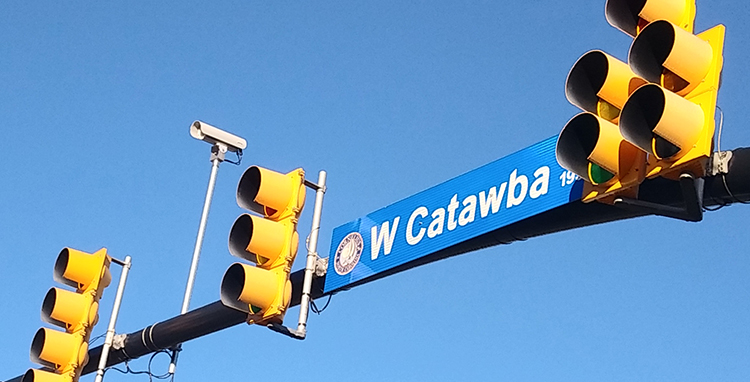
Jan. 2. By Dave Vieser. Alert motorists may have already noticed the new cameras on top of signal arms along West Catawba Avenue between Hwy. 21 and Jetton Road.
Big Brother isn’t watching you, he’s just monitoring traffic flow.
It’s all part of a $548,000 joint project called Adaptive Signal Control Technology (ASCT). The system, which should go on line around the first of the year, will connect seven traffic lights with analytic cameras to automatically adjust signal intervals based on real-time conditions.
The Town of Cornelius pays 28 percent of the total cost, or $152,000.
Motorists will notice the difference, according to Rhythm Engineering Vice President Mark Sullivant. The project is a joint effort between Cornelius, NCDOT and Rhythm.
“The traffic signals will not cycle like they used to. The system is designed to give green lights to the lanes that need them only for the amount of time necessary and then quickly move on to where the system sees the next highest demand.”
That means the traffic signal patterns may be less than predictable. Motorists will need to stay alert since the lights will cycle more quickly than the time-based cycle currently in use.
In addition to the cameras, diamond shaped radio transmitters have been installed on the side of the road at each of the seven signals, which allow the signals to literally “talk to each other” and establish the optimum flow for traffic.
The goal of this pilot project is to reduce waiting times at each intersection, which will, in turn, improve travel times along the corridor.
The signals along this section of West Catawba Avenue are not all that old, having been installed during the Phase One widening project in 2011. Sullivant says his adaptive system will not replace, but rather enhance the existing signals.
Rhythm has had success working with transportation departments in many other parts of the country, including Virginia and Florida.
NCDOT will foot 29 percent of the cost or $161,000. The remaining 43 percent, or $235,000, is from Rhythm.
Rhythm contributed a portion of the costs to get their name known and use the Cornelius project as a sample for future business in this region.




